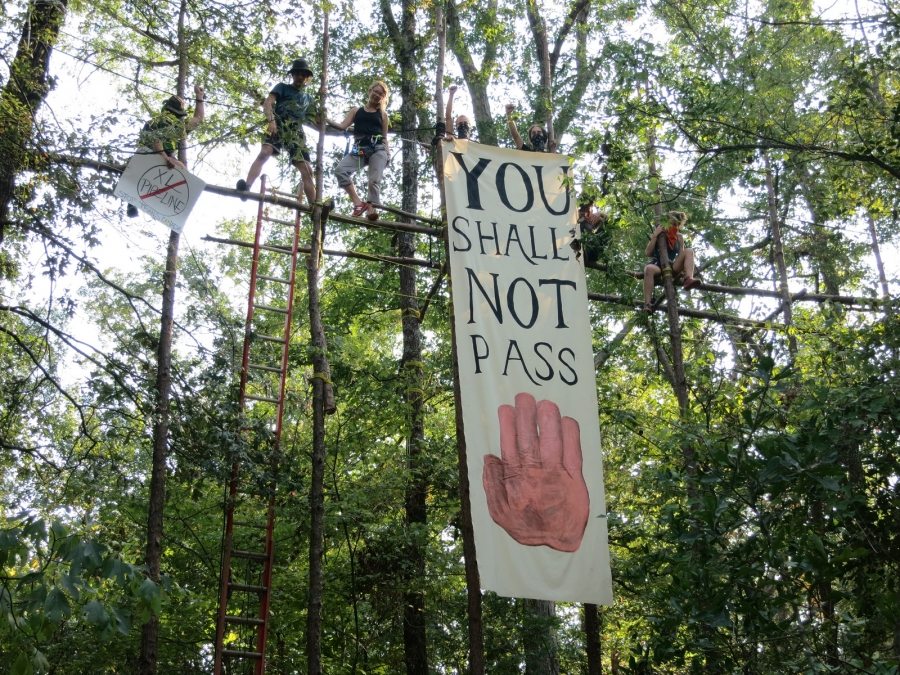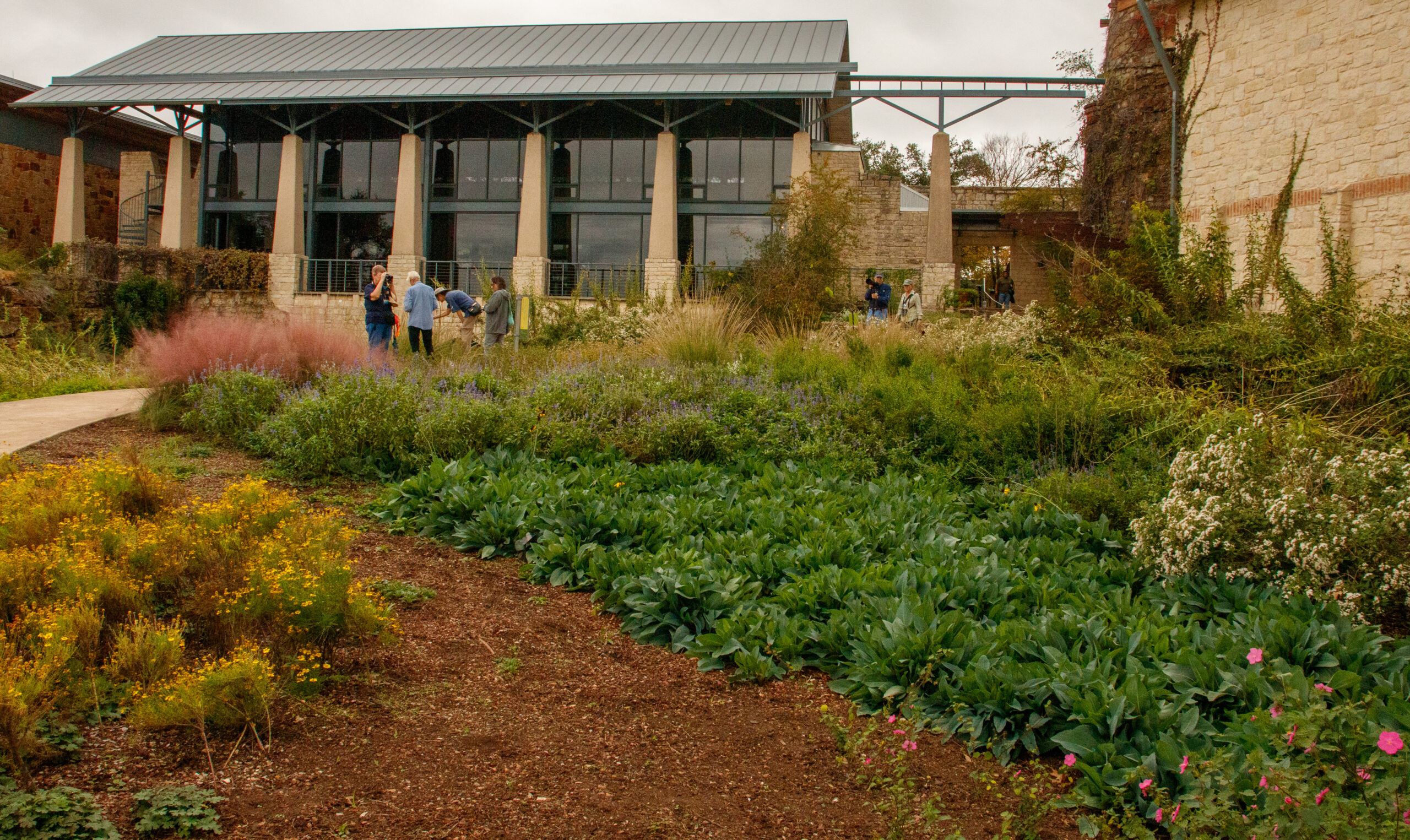
The Keystone XL Battle Comes to East Texas
Landowners join environmental protesters to block the Canada-to-Texas pipeline.

IN A RURAL TOWN IN East Texas, a battle is being waged between a multinational energy corporation and an alliance of rural landowners and environmental activists.
A gravel road leads to the battleground. Towering oaks punctuate the gray October sky and the damp ground is overgrown with moss. It’s a fairy tale-like scene, marred by yellow police tape and the grating of heavy machinery slicing through trees and heaving up soil.
This forest near Winnsboro is the unlikely epicenter of a growing movement to halt the Keystone XL pipeline, slated to bring oil stripped from the tar sands of Canada to the Texas Gulf Coast. In an effort to stop the steady progress of the pipeline, protesters have taken to the trees—living on wooden platforms 80 feet in the air. Their platforms dot the tree canopy within an easement obtained by TransCanada, the corporation building the pipeline.
The tree-sitters have been living in this tree village, which they’ve dubbed “Middle Earth,” for a month. Their world is confined to the 4-by-6-foot platforms and the ropes connecting them. They’re able to zipline between platforms, but the structures only offer enough room to sit or lay. If they want to stretch their legs, they use a catwalk—nicknamed “Helm’s Deep”—that extends 100 feet across the tree village’s northern boundary. Below, a police officer asks anyone who approaches the easement for identification and waits to arrest any protesters who might come down.
In this increasingly tense showdown, the stakes couldn’t be higher. Presidential candidate Mitt Romney promised to build Keystone XL himself if elected to curb U.S. dependence on foreign oil. On the other side of the debate, environmentalists view stopping the pipeline as essential to keeping vast amounts of carbon in the ground and out of the atmosphere. And landowners, farmers and even some tea party types up and down the pipeline route are raising a host of objections, from potential contamination of aquifers to the trampling of private-property rights.
In East Texas, police have cut off blockaders from their supporters and made at least 30 arrests, including a 78-year-old woman taken into custody on her own property. Meanwhile TransCanada has taken to the courts to subdue protesters.
If built, the 830,000 barrel-per-day Keystone XL pipeline will more than double the capacity of the existing 590,000 barrel-per-day Keystone pipeline and open up the Canadian tar sands to a global market hungry for oil. Environmentalists and climate scientists argue that mining the tar sands for bitumen, a tar-like fossil fuel, will accelerate climate change in addition to a host of other environmental problems. Tar sands extraction and processing requires energy-intensive surface mining in Canada and uses up water resources to separate the tar-like bitumen from sand and water. The bitumen is diluted with natural gas condensate that often includes benzene, a carcinogen, so it can be transported through pipelines to refineries.
Because of the density of tar sands crude, spills can be devastating. Rather than floating on the top, the substance sinks to the bottom, creating a clean-up problem experts don’t yet know how to solve. In 2010, the Canadian company Enbridge failed to detect a leak in its tar sands pipeline in Michigan. At least 1.1 million gallons of oil oozed into a tributary of the Kalamazoo River, much of it sinking to the bottom. Portions of the river remain closed.
TransCanada says Keystone XL will be the safest pipeline ever built, but their current Keystone pipeline has already had 35 leaks in its first two years, according to a March 2012 report by Cornell University.
The tar sands also contain vast amounts of carbon. In 2010, the EPA estimated that greenhouse gas emissions from the tar sands would be 82 percent greater than conventional crude oil. NASA scientist James Hansen described the climate impacts bluntly: “If Canada proceeds [with exploiting tar sands], and we do nothing, it will be game over for the climate.”
TEXAS IS ONLY THE MOST recent battleground over the tar sands. Canadians have organized mass demonstrations since last year. Last week, thousands in British Columbia participated in a sit-in against mining the tar sands. On this side of the border, Nebraskans came together to oppose the pipeline’s route through the Sandhills, a fragile ecosystem overlying the Ogallala aquifer, and successfully pressured TransCanada to reroute the pipeline around the area. And last year a series of protests in Washington, D.C., culminated with about 10,000 people demonstrating outside the White House in November and more than 1,000 arrests.
In January, pipeline opponents scored their biggest win. President Obama denied TransCanada a permit to build across the international border. But it may have been a Pyrrhic victory. A few months later, Obama stood in front of a stack of pipes in Cushing, Oklahoma and announced that he would expedite the permitting process for Keystone XL’s southern leg, from Cushing to its terminus in Port Arthur. Suddenly, the opposition found itself having to do battle in the oil patch.
Soon after Obama’s March announcement, environmental activists began to band together, with their nucleus forming in Denton, Texas. By April, the group had national support and individuals came from other states to stand against the pipeline. They called themselves the Tar Sands Blockade and joined with local landowners who wanted to stop pipeline construction on their properties. In September, a group of six to 11 protesters (they won’t specify how many) took to living in the trees on the property of one such landowner, David Daniel, and by late October four still inhabited the tree canopy. After 25 days of blockading, two protesters came down in mid-October and were instantly arrested.
“It’s one of the main tools we have outside of litigation,” says J.G. Genson, a blockader who is not participating in the tree-sit. “We’re trying to slow or stop them every step of the way … the longer [our blockades] can last the more we disrupt their logistics as well as continue to get the word out that this is going on.”
On a different front, Texas landowners are losing an eminent domain battle against the foreign corporation.
In early October, 78-year-old Eleanor Fairchild was arrested for trespassing on her own property. Fairchild and actress Daryl Hannah were arrested as they stood in front of an excavator working in the TransCanada easement.
Fairchild is one of the few landowners who have spoken out against what they believe is TransCanada’s abuse of eminent domain power. TransCanada representatives have offered them a pittance to use their land for construction of the pipeline, several landowners complain. Where landowners have resisted the offers, TransCanada representatives have threatened to condemn the land through eminent domain. Many say they were intimidated into signing, while others have refused and had their land seized anyway.
“TransCanada are a bunch of bullies and they’re trying to scare us and I’m not going to be scared,” Fairchild told the Observer. In March 2009, TransCanada approached her about using nearly a mile of her land to build the pipeline. They told her she wouldn’t be able to drive trucks or tractors over the pipeline, which meant she couldn’t develop or get farming equipment to about 90 acres of her 350-acre farm, she says.
After repeated calls from a land man employed by TransCanada, Fairchild turned the matter over to her attorney. TransCanada upped its initial offer of about $42,000 to $60,000, but Fairchild wanted the company to plant trees back around the easement. TransCanada refused. She then rejected the deal, so the company went to court. A panel of commissioners appointed to hear the case awarded Fairchild just over $24,000.
As a private, foreign-owned company, TransCanada is able to condemn land through eminent domain because it’s been granted “common carrier” status, which means it promises to serve the public good by offering to transport competitors’ oil. Companies obtain the designation merely by checking “yes” on a box when they apply for a permit with the Texas Railroad Commission. The commission has no legal authority to enforce this provision, however, so the common carrier status stands unless challenged by a landowner in court.
In August, the Texas Supreme Court handed a narrow victory to landowners in its Texas Rice Land Partners v. Denbury Green decision. The court ruled that pipeline company Denbury Green “must do more than check a box on a government form” to become a common carrier.
Despite this ruling, courts have consistently ruled in favor of TransCanada, granting the company land along its pipeline route. Julia Trigg Crawford, a farmer who lives near Paris, challenged TransCanada’s common carrier status. A Lamar County judge recently upheld TransCanada’s right to condemn her land. Crawford said she plans to appeal.
David Holland, whose family has owned the land in the Rice Land Partners case since 1878, is also challenging TransCanada’s eminent domain power.
While landowners fight TransCanada, the company is suing those who have physically stood in its way. The company recently filed a trespassing suit against 26 people and three organizations, including the Tar Sands Blockade. The lawsuit names six “John and Jane Does” – the tree-sitters the company has yet to identify – as well as Eleanor Fairchild and Tar Sands Blockade spokesperson Ron Seifert.
“They try to frame it as though we’re the criminal element in this, when in reality they’re the ones abusing eminent domain laws, they’re the ones bullying landowners systematically,” Seifert says. “In my view it’s no different than the shakedown you would see in a mafia situation.”
But TransCanada isn’t the only one making a buck. The company is hiring off-duty police officers and deputy sheriffs to work private security on its easements. When I visited the tree village on a Saturday in October, four officers and deputies were on-hand, some taking photos of us while I interviewed a tree-sitter. One officer belonged to the Savoy Police Department, a town 90 miles east of Winnsboro. He declined to comment on whether he was working private security.
As we left a local landowner’s property on a Sunday night, a deputy sheriff asked the landowner, Susan Scott of Winnsboro, for identification and threatened to arrest her if she stepped onto the easement yards away from her house.
The Observer attempted to reach Wood County Sheriff Bill Wansley, but calls and messages were not returned. TransCanada did not respond to several calls and emails.
Since blockade actions started, officers have chased, tased and pepper-sprayed protesters attempting to block machinery. As of late October, at least 30 people had been arrested while either participating in or documenting actions, 20 of them from Texas. A reporter and a photographer working for the New York Times were briefly detained in mid-October.
The Tar Sands Blockade recently held an “action day” where more than 50 protesters stormed the tree village and easement, with some people blocking machinery and others resupplying the tree-sitters. Eight people were arrested at the event, which followed a weekend-long “action camp” where close to 100 people were trained in nonviolent direct action tactics and organizing.
But blockaders say a national effort is needed in the “asymmetrical battle” to stop the pipeline. Until they can get the word out and get others across the country to join their fight, they’re not backing down.
“If we were moths, then the Tar Sands Blockade is the biggest light in the world because of the magnitude of the destruction and the threat to the well being of our entire planet,” Genson says. “We’re definitely not going to restrict ourselves to the current tree village. … The Keystone XL pipeline needs to be challenged along its entire route and as long as they’re trying to build it we’re going to be taking direct action to stop it.”


